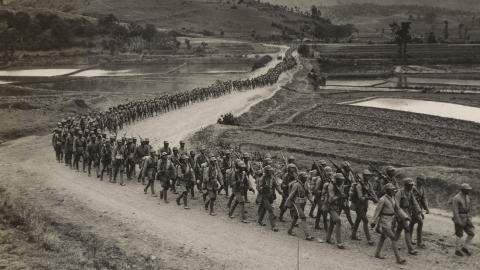WW2's greatest air battles
Since time immemorial, there has always been conflict. People have fought each other for lots of reasons including economic or territorial gain, religious, political or nationalist ideology, revenge or, in the case of Remontel, an expatriate French chef living in 19th century Mexico City, a pastry shop.
It was ransacked by looters in an 1828 uprising which led to war between France and Mexico when the Mexican government refused to pay the French fondant fancy fabricator 600,000 pesos in compensation.
The instruments of war, from clubs, trebuchets and boiling oil to swords, muskets and rifles have all proved effective, but as we turned the corner from the 19th to the 20th century, we saw a paradigm shift in how wars were fought.
The fight in the sky
The Chinese progressed from kites to balloon warfare sometime during the late second or early third century and the French used a tethered balloon at the Battle of Fleurus in 1794 but there were drawbacks in that they were susceptible to inclement weather as well as the fact that they were large and slow, rendering them sitting ducks.
The American Civil War was the first conflict that witnessed the sustained use of battle-based aeronautics with balloons being used by spotters to look for rebel encampments and with flag signals, directing artillery fire to their intended targets but by the summer of 1863, virtually all balloon recon had stopped.
In the years preceding World War I, the US Navy experimented shooting guns from a plane and the first use of aeroplanes in war occurred during the Italo-Turkish War in 1911 with Italian Blériot XI and Nieuport IV monoplanes attacking a Turkish base in Libya.
A year into World War I saw the birth of aerial combat, known as dogfighting but it was during World War II that the use of aircraft as fighting machines came into its own. Contemporary planes were faster, could fly for longer and could carry more and there were entire battles fought exclusively in the air, in fact, some of the most famous air battles in the history of warfare…
Battle of Britain
When: 10th July - 31st October 1940
Who: the Royal Air Force and the Luftwaffe
Described as the first major battle fought entirely in the air, the Battle of Britain holds the odd distinction of being named before it was fought. It was mentioned in a speech given by the Prime Minister three weeks before it started.
‘What [French military commander] General Weygand called ‘The Battle of France’ is over. I expect that the battle of Britain is about to begin…’
Winston Churchill, 18th June 1940
In July 1940, Hitler suggested that ‘the British Air Force must be eliminated to such an extent that it will be incapable of putting up any sustained opposition to the invading troops’. He wanted the swastika flying over Big Ben by Christmas 1940 and gathering three air fleets made up of 2,500 aircraft, the Luftwaffe began their airborne assault by attacking coastal targets and ships operating in the Channel.
Moving inland, they focused their attention on airfields and communications centres and while they did some serious damage, the German High Command over-estimated what damage they had done and wrongly assumed the RAF was on its last legs.
In an error of what came to be of critical importance (and potentially cost the Germans the entire war), the Germans moved the weight of their attacks to London rather than continuing to cripple airfields and infrastructure. It had a devastating effect on the city and its residents but crucially gave the RAF time to recover.
The German fighter planes lacked the range to escort their bombers deep into British territory and taking heavy losses, their assault was becoming increasingly unsustainable. It was becoming clearer with each downed plane that the Germans had dramatically failed to secure the air superiority they needed for a massive ground invasion.
The Luftwaffe was dealt a blow from which they never really recovered. Britain and its Allies were able to stay in the war despite suffering heavy losses both in terms of air power and civilian deaths but victory allowed Britain to quickly rebuild its air defences which served as the base for the liberation of Western Europe and onto a decisive victory in 1945.
The Dieppe raid
When: 19th August 1942
Who: Allied Forces and Germany
The largest single-day air battle of World War II was also an unmitigated disaster for the Allied forces. Over 6,000 mostly Canadian infantrymen landed at the German-occupied French port of Dieppe tasked with seizing and holding the port, destroying the coastal defences, gathering intelligence and rendering the port entirely inoperable. In addition, the operation was designed to boost morale and to demonstrate Britain’s commitment to opening up a western front in northern Europe.
However, the raid was destined for failure even before it started. There was a distinct lack of intelligence about the German defences (who knew in advance what the Allies were going to do thanks to French double agents), there was confusion and last-minute changes to operational plans and crucially for a raid of this nature, there was little or no element of surprise.
Almost none of the objectives were met. Fire support was massively inadequate and the landing forces became very quickly trapped on the beaches. Despite the RAF sending 74 squadrons (and the Royal Navy sending 237 ships including eight destroyers), the Allies were overrun.
The RAF failed to lure the Luftwaffe into open battle and the final balance sheet showed heavy Allied losses. Exact figures are disputed but one source puts the loss at 88 fighter planes (including 44 Spitfires), 10 reconnaissance aircraft and eight bombers. Other sources claim the figure was as high as 70 Spitfires and 28 bombers. Suffice it to say that the Dieppe Raid didn’t go according to plan.
Of the 6,000 men who landed, over 60% were either killed, wounded or captured but if there was a positive that could be taken from such a failure, it was what not to do when landing on a beach, a lesson heeded on D-Day.
The Battle of Kursk
When: 4th July – 23rd August 1943
Who: The Soviet Union and Germany
After the Red Army significantly weakened the Germans at the Battle of Stalingrad the previous winter, the Germans, knowing it was their last chance to regain dominance on the Eastern Front, launched an offensive intended to eliminate the Soviets at Kursk, allowing Hitler to divert his troops to the Western Front.
In what has been described as the greatest battle of World War II and the war’s turning point, (and in a war of staggering numbers), Kursk outdid them all. Three million men, eight thousand tanks and five thousand planes broke all previous records for the costliest single day of aerial warfare and the largest tank battle in history.
Three thousand miles of trenches were dug, 500,000 anti-tank mines were laid, as were 440,000 anti-personnel mines and in preparation for the battle, around a third of the entire German military war machine was focused there.
As the battle drew to a close, the Soviets lost almost 2,500 planes while the Germans lost around 800
Even though the Soviets had a numerical 2:1 advantage, the Germans had supreme confidence – as they often did – that their equipment and tactics were far superior and at Kursk they had a point. Their Bf 109 was faster and more manoeuvrable than the Soviet Yak-1 and had far more firepower.
As the battle drew to a close, the Soviets lost almost 2,500 planes while the Germans lost around 800. While the Red Army was able to absorb such heavy losses and replace men and machines, the Germans couldn’t and the Soviets gained the operational advantage on the Eastern Front from which the Germans never fully recovered.
As the Germans were getting battered at Kursk, the Western Allied landings in Italy opened up a new front which diverted progressively thinner German numbers.
Big Week
When: 20th – 25th February 1944
Who: Allied Forces & Germany
‘We must get the USAAF to wade in with greater force. We can wreck Berlin from end to end if the USAAF will come into it. It will cost between us 400-500 aircraft. It will cost Germany the war’
Marshal of the Air Force Sir Arthur ‘Bomber’ Harris in a letter to Churchill, 3rd November 1943
It became clear that a land invasion of Europe’s mainland could not be possible without reducing the Luftwaffe to a street gang so the British and Americans conducted a week-long sequence of air raids designed to completely demobilise the industrial backbone of Germany’s aircraft industry.
Beginning with an 823-strong bomber raid on the Leipzig Messerschmidt factory, the next day saw a thousand bombers (B-17 Flying Fortresses and B-24 Liberators) supported by 700 fighters including Lockheed P-38 Lightnings, Republic P-47 Thunderbirds and American P-51 Mustangs attack a further 12 targets including a return to Leipzig.
Over the next few days, factories in Braunschweig, Gotha, Augsburg, Stuttgart and Regensburg were bombed and after 3,300 Allied sorties, 226 bombers were lost as were 28 fighters. The Germans lost 290 fighters (and along with them their best pilots) with a further 90 grounded and while the Nazi war machine was halted, it wasn’t entirely destroyed as per the original plan.
Soon after Big Week ended, US General Dwight D Eisenhower took control of the air forces in preparation for an all-out invasion of France and the Allies were well on the way to achieving air and ground superiority and onto victory.
And finally, the air battle very few know about that should never have happened….
The Air Battle Over Niš
When: 7th November 1944
Who: The United States & The Soviet Union
One of only two military meetings between the USA and their Cold War counterparts, the air battle over Niš in Serbia was a terribly unfortunate case of friendly fire.
After the Belgrade Offensive where the city was liberated from the German Wehrmacht by the joint efforts of the Red Army, the Yugoslav Partisans and the Bulgarian People’s Army, a convoy of vehicles from the 6th Rifle Corps of the Red Army were ordered to reinforce the southern wing of the Hungarian Front and they moved in convoy from Niš towards Belgrade.
At the same time, three groups of US P-38 Lightning fighters were ordered to attack German ground troops near Kosovo and upon seeing vehicles and marching troops, started to fire. Unfortunately they were 250 miles off course and unbeknownst to the Americans, they were in fact attacking their allies, the Russians.
The first sortie took out most of the leading vehicles and as the second arrived, General Sudec of the 17th Air Army ordered immediate retaliation believing they were being attacked by German Focke-Wolf Fw 189 fighters and put the Soviet Yakovlev Yak-3 fighters in the air.
Numbers are sketchy but contemporary sources put the number of P-38s downed at three and the number of downed Yak-9s at 3-4. After the ‘battle’, everyone was sworn to secrecy – presumably due to embarrassment more than anything else – and the US apologised to the Soviets but questions remain unanswered to this day. How did the Americans veer so far off course? How many planes and personnel were involved and subsequently lost?
Army Chief of Staff George C Marshall offered to send liaison officers to the 3rd Ukrainian Front but Stalin rejected the offer. Was Niš the start of the Cold War? Perhaps…
















